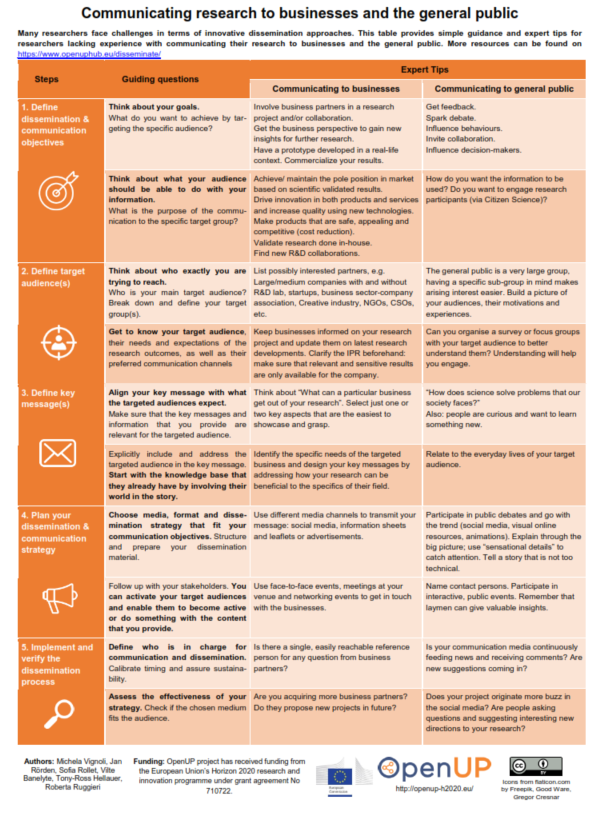Disseminating to businesses
 |
All you need to know to promote your research to businesses - The "why", the "what" & the "how" in disseminating to businesses. |
1. Requirements and expectations: Why do businesses need information from research?
In general, businesses want to stay up to date about what is going on in research projects and not miss latest developments that are relevant for their own developments, services and products. This is particularly true for businesses without an own R&D department.
Businesses are also interested in finding new R&D cooperation partners, e.g. to outsource R&D activities, share resources, or validate research done in-house. In this context having strong IPRs is very important for businesses.
In some areas, e.g. in health society or public technology, businesses need input from independent research providing independent data confirming that their products are safe, have an effect, or an overall positive risk-benefit balance. Examples are public debates with environmental organisations or the general public.
The need by businesses to receive information from some research areas (e.g. arts and humanities, social sciences) might not seem evident. In these areas, there is a bigger discrepancy between science and businesses.
In commissioned consulting, businesses expect the experts to deliver a clear and quick answer to a problem. They are not looking for possible solutions and their caveats; they want clear answers that help them solving problems that they encounter in practice.
Businesses are also interested in finding new R&D cooperation partners, e.g. to outsource R&D activities, share resources, or validate research done in-house. In this context having strong IPRs is very important for businesses.
In some areas, e.g. in health society or public technology, businesses need input from independent research providing independent data confirming that their products are safe, have an effect, or an overall positive risk-benefit balance. Examples are public debates with environmental organisations or the general public.
The need by businesses to receive information from some research areas (e.g. arts and humanities, social sciences) might not seem evident. In these areas, there is a bigger discrepancy between science and businesses.
In commissioned consulting, businesses expect the experts to deliver a clear and quick answer to a problem. They are not looking for possible solutions and their caveats; they want clear answers that help them solving problems that they encounter in practice.
2. What information do businesses require from research?
Depending on the research area, information required from research varies. For example in the manufacturing industry information is needed to reduce costs, make products more attractive, and to maintain/achieve the pole position on market.
On the one hand, industry is interested in using the results from research. For them it is essential to know how to access the results, under which licenses, and if they are openly available. It is important for them to know which IPRs apply and which of the results can be re-used. This information should be well understandable.
On the other hand, businesses do not only need research outputs such as concrete results, papers, patents. They are interested in updates on any latest research development. This can include everything up to messages or short reports on what you are up to right now.
Businesses also need people. They want to know principle investigators in their own sectors to be able to collaborate. Not only do they want to know about events that researchers are attending. They are also looking for individual experts in the field and their expertise. Businesses are always looking for opportunities to get to know researchers and find possible collaboration opportunities.
On the one hand, industry is interested in using the results from research. For them it is essential to know how to access the results, under which licenses, and if they are openly available. It is important for them to know which IPRs apply and which of the results can be re-used. This information should be well understandable.
On the other hand, businesses do not only need research outputs such as concrete results, papers, patents. They are interested in updates on any latest research development. This can include everything up to messages or short reports on what you are up to right now.
Businesses also need people. They want to know principle investigators in their own sectors to be able to collaborate. Not only do they want to know about events that researchers are attending. They are also looking for individual experts in the field and their expertise. Businesses are always looking for opportunities to get to know researchers and find possible collaboration opportunities.
3. How should the key message(s) be structured?
Make sure to align your research with what the targeted businesses do. To make the message more interesting for the targeted businesses, make sure to transform it to fit their requirements and expectations. For instance, if they are producing a product or offering a service, how can your research contribute to those? If they are producing washing machines, could you write a story about your research and a washing machine?
Explain what you are doing and get the key message to your audience. Start with the knowledge base that they already have by involving their world in the story. As a result, the message will be easier to understand, and it gets a personal touch. People like it if you are interested in what they are doing. It is important to be open to discussions, and have a platform for businesses to enable a two-way communication.
In context of commissioned research, the specifications of the requested research reports are set and communicated by the company. In these cases, the company should receive the information in exactly the format requested. Businesses will have trained staff who can deal with scientific information.
It is crucial to clarify the IPR beforehand: make sure that relevant and sensitive results are only available for the company.
Explain what you are doing and get the key message to your audience. Start with the knowledge base that they already have by involving their world in the story. As a result, the message will be easier to understand, and it gets a personal touch. People like it if you are interested in what they are doing. It is important to be open to discussions, and have a platform for businesses to enable a two-way communication.
In context of commissioned research, the specifications of the requested research reports are set and communicated by the company. In these cases, the company should receive the information in exactly the format requested. Businesses will have trained staff who can deal with scientific information.
It is crucial to clarify the IPR beforehand: make sure that relevant and sensitive results are only available for the company.
4. Form/format of communication to businesses
As already mentioned, the business target audience is big. There is no format fitting all sectors and businesses. To find out what your own sectoral industry wants, talk to them and ask how they are usually getting their information from research. This can be a good first orientation. However, different players will give you different answers. Try to create a two-way communication.
It is recommendable not to go just with one format. Use 3-4 main formats that your target audience uses. Always think multi-canal and multi-format. Do not put all energy in one big campaign. Use various tools, e.g. video, social media strategy, marketing actions, paid media, price relations, public relations (influential bloggers). All these tools and approaches can complement one another. Doing communication well is a big job, and it does not necessarily lead to success. You can do it right and still fail to reach a lot of impact.
Communication material should be in the language that your target audience understands best. To achieve a broad dissemination, in particular for EU projects, use English as dissemination language. For national projects use the national language; but always provide an executive summary in English.
Next to producing e.g. texts, leaflets, blogs, or videos, an important format is directly involving your target groups in face-to-face events or meetings. For example, you can organise special workshops for industry partners in context of your research project.
Another possibility is to invite industry audience to talks and conferences. This is, however, not always easy if those events are geared towards academics. Business audiences are not that much interested in getting to know comprehensive technical details; they want to know what the main output is, how it can help the company and how they can apply it. Choosing appropriate formats to present to and discuss this with them in a two-way communication is recommendable.
To generate interest about your events targeting businesses you can advertise and disseminate them via social media channels (e.g. Twitter, LinkedIn) and buzz marketing. It is necessary to get connected with your peers through various channels and to see it as an integrated strategy. Decide in how many channels you need to go to be well connected, and try to get the right topic to generate a buzz. ResearchGate is not recommended as this network is mostly used to reach peers from research.
It is recommendable not to go just with one format. Use 3-4 main formats that your target audience uses. Always think multi-canal and multi-format. Do not put all energy in one big campaign. Use various tools, e.g. video, social media strategy, marketing actions, paid media, price relations, public relations (influential bloggers). All these tools and approaches can complement one another. Doing communication well is a big job, and it does not necessarily lead to success. You can do it right and still fail to reach a lot of impact.
Communication material should be in the language that your target audience understands best. To achieve a broad dissemination, in particular for EU projects, use English as dissemination language. For national projects use the national language; but always provide an executive summary in English.
Next to producing e.g. texts, leaflets, blogs, or videos, an important format is directly involving your target groups in face-to-face events or meetings. For example, you can organise special workshops for industry partners in context of your research project.
Another possibility is to invite industry audience to talks and conferences. This is, however, not always easy if those events are geared towards academics. Business audiences are not that much interested in getting to know comprehensive technical details; they want to know what the main output is, how it can help the company and how they can apply it. Choosing appropriate formats to present to and discuss this with them in a two-way communication is recommendable.
To generate interest about your events targeting businesses you can advertise and disseminate them via social media channels (e.g. Twitter, LinkedIn) and buzz marketing. It is necessary to get connected with your peers through various channels and to see it as an integrated strategy. Decide in how many channels you need to go to be well connected, and try to get the right topic to generate a buzz. ResearchGate is not recommended as this network is mostly used to reach peers from research.





